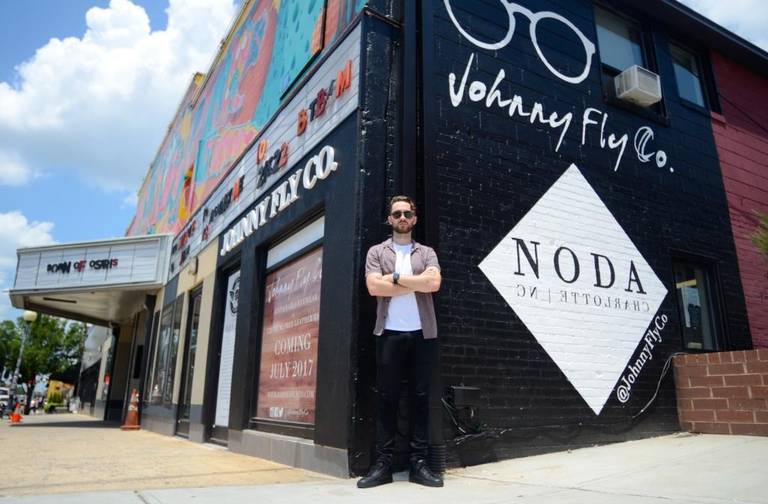
John Freeman hears it a lot: Why are you opening a physical store to sell your sunglasses, when you already have a thriving online business?
“Everyone says you are going to the opposite direction of the trend,” Freeman said last week, sitting outside the Smelly Cat Cafe in NoDa, across from the site where Johnny Fly opened its first brick-and-mortar store on Wednesday.
To him, it’s all about the experience. “Eyewear is the kind of thing that you really need to try on,” he said. “It’s really hard to know it, unless it’s on your face.”
At a time when you can buy groceries using delivery services like Instacart and shop for your socks and microwave on Amazon, Freeman is betting that his retail store, featuring the sunglasses and leather bags he designs, will achieve the same success as the online store he founded more than five years ago.
In opening its first brick-and-mortar retail store, at 519 E. 36th St. in NoDa, Johnny Fly is riding a larger wave: More online retailers are opening physical stores to let customers see, feel and touch their products.
Fabletics, actress Kate Hudson’s activewear line that sells personalized athletic outfits and accessories online, opened a store in SouthPark last summer, and online eyeglass retailer Warby Parker opened a store earlier this year in Atherton Mill.
Nationally, retailers are turning the tables, too. Plus-size online retailer Eloquii and online consignment retailer ThredUP are also opening stores.
Even Amazon, the e-commerce giant, tested the water in May by opening its first brick-and-mortar bookstore in New York City. And Amazon Prime members can pick up their groceries in Amazon storefronts in Seattle.
At the same time, big, traditional retailers are closing stores as more consumers turn to e-commerce. Macy’s, J.C. Penney, The Limited, J. Crew, Wal-Mart Neighborhood Market, Kmart, Kohl’s and Wet Seal, have all closed stores in Charlotte in the past few years.
Though e-commerce has experienced fast growth, it still constitutes only a small share of retail sales, accounting for 8.3 percent of total sales in the fourth quarter of 2016. E-commerce sales increased 14.1 percent, compared with a 3.9 percent gain for total sales, according to U.S. Department of Commerce.
‘Touching and feeling’
To Internet-savvy customers, the attractiveness of brick-and-mortar stores comes from their ability to allow them to actually test and experience the products.
Fresh goods and apparel are the two kinds of products that customers tend to buy in brick-and-mortar stores, said Meaghan Werle, retail analyst at Kantar Retail.
Nima Jalali, a marketing professor at UNC Charlotte, said compared with “search” goods that have specific, relatively fixed attributes – think electronics and tools – brands that offer “experience” goods, such as clothing, jewelry and glasses, are more likely to open physical stores.
Miari Monahan bought a pair of eyeglasses on Warby Parker’s website, then went to the retailer’s Atherton Mill store last week to have them adjusted. “It is a little easier to try on and look at the ones that I really would like or not like, if I want new frames,” she said. Next time she needs a pair of glasses, she said, she’ll probably come back to the store.
Even if customers buy an item online, a physical store still plays a role: “It’s really for consumers to touch and feel the products, not necessarily to buy them in the stores,” said Linyun Yang, a marketing professor at UNC Charlotte.
Another benefit: Opening a store can help an online retailer build awareness of their brand, Jalali said. “Its reach may not be as much as online’s, but you start to build a brand. Once you have a brand, you can start to increase the price a little bit,” he said.
Currently, each pair of sunglasses at the Johnny Fly store is priced between $74 to $120 – about the same as the retailer’s online offering.
Freeman also values the close connections established between the salespeople and the customers for in-store purchases.
“I do feel like there is a new coming of customers who want to see and touch and have that relationship,” Freeman said. “You want the relationship, the warranty and the things that stand behind it, something you don’t get with a computer screen very often.”
The risks
A long-time online shopper himself, Freeman said he hesitated to open a brick-and-mortar shop until he did a trial run of a physical store at Birkdale Village in the Lake Norman area for the month between Black Friday and New Year’s. He realized customers really want to have the in-store purchase experience.
Another factor to consider: the costs.
Contrary to conventional wisdom, e-commerce is not a cheap option for retailers. Stand-alone e-commerce companies are almost all struggling to make a profit. Traditional retailers, such as J.C. Penney and Kohl’s, also reported higher profitability for in-store sales compared with online sales.
This is primarily because e-commerce pure-plays have additional fulfillment costs associated with shipping, Werle said, citing expenses for using third-party delivery services including FedEx and UPS.
Citing the trial run of his physical store last year, Freeman said the brick-and-mortar sales revenue was about the same level as the company’s online sales during the testing month.
From last July to date, Johnny Fly has sold over 4,500 pairs of sunglasses.
Freeman said he expects the increased revenue from offline sales can offset additional spending incurred by opening a physical store, including rent and labor costs.
“Our volume increased very quickly when we sold eyewear in-person (during the trial run)… I definitely think the volume will help with the costs of the store,” Freeman said.
The interactive experience
Opening a brick-and-mortar store, Freeman said, also allows him to have detailed feedback from customers so that he can know which aspect of the products need to work on.
“A lot of online stores are utilizing their data to optimize the in-store experience,” Werle said.
As online services accumulate different kinds of data from users, retailers can also use the data to strategically locate their physical stores, Jalali said.
“They have the data. They know what’s working and what’s not working. Every piece of (customers’) action is recorded, whereas offline this is not the case,” he said.
The online and offline stores together create an omnichannel for the customers, especially when considering the majority of young customers would research online before making purchase decisions in stores, according to Retail Touch Points.
Many retailers found that there is a blurry line between online and offline sales. For example, J.C. Penney reported that in 2016, 77 percent of all online orders touched a physical store by means such as in-store returns and pick-ups of online orders, according to its annual report.
One advantage of transforming from a solely online retailer to offer products both online and offline, Freeman said, is that his online competitors are no stranger to him.
“I have control of my online competition, at least as far as the frames go,” Freeman said. “You know, I am not going to be undercut by Amazon unless I choose to be undercut by Amazon.”
VIA THE CHARLOTTE OBSERVER


